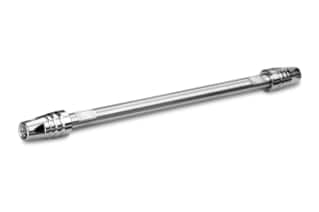
|
Separation Mode |
SEC/GPC |
|
Particle Substrate |
Hybrid |
|
pH Range Min |
1 pH |
|
pH Range Max |
8 pH |
|
Endcapped |
No |
|
Silanol Activity |
Medium |
|
Molecular Weight Range Min |
20000 |
|
Molecular Weight Range Max |
40000 |
|
Particle Shape |
Spherical |
|
Particle Size |
2.5 µm |
|
Endfitting Type |
Parker-style |
|
Pore Size |
450 Å |
|
Format |
Column |
|
System |
APC |
|
Particle Technology |
BEH |
|
Technique |
SEC |
|
Inner Diameter |
4.6 mm |
|
Length |
150 mm |
|
eCord |
Yes |
|
UNSPSC |
41115709 |
|
Brand |
ACQUITY APC |
|
Product Type |
Columns |
|
Units per Package |
1 pk |

ACQUITY APC AQ BEH Column, 450 Å, 2.5 µm, 4.6 mm X 150 mm, 20K - 40K, 1/pk
High-performance chemistries found in ACQUITY® Advanced Polymer Chromatography® (APCTM) Columns enable quick and precise chromatographic characterization of synthetic polymer and macromolecular species. The innovative hybrid-polymer sub-3-m particle technology outperforms traditional polymeric-based phases in terms of chromatographic efficiency, stability, and method adaptability when compared to existing polymer characterization techniques. All polymer classes, including aqueous and organic soluble polymers with low molecular weight, can be chromatographically separated with great success using ACQUITY APC Columns.
For the characterization of water-soluble polymers, ACQUITY APC AQ columns are created to offer incredibly effective size-based separations. The sorbent employs patented Ethylene Bridge Hybrid (BEH) technology to create a mechanically strong packed bed that resists shrinking and swelling, allowing for simple mobile phase solvent switching. This column's molecular weight range is expected to be between 20,000 and 400,000 g/mole.
ACQUITY APC Columns outperform conventional polymer-based stationary phases in terms of separation speed, resolution, and chromatographic efficiency due to increased pore volume and particle size. When the solvent is changed, the laboratory equipment creates a stable bed, which prevents the shrinking and swelling that occurs with polymeric stationary phases. The analytical column is manufactured in the Waters chromatography chemistry manufacturing plant in accordance with the most stringent cGMP and ISO 9002 standards. Every step of our column manufacturing process is monitored and closely managed, from raw material characterization to final batch analysis, to ensure unrivaled product reproducibility.
Visit our website to shop for lab equipment and browse through our website, refer to our catalog, and ensure your lab needs nare addressed as needed. You might also be interested in reviewing Neutrals QC Reference Material; The Neutrals QC Reference Material is applicable to all chromatographic systems with UV detectors. It is intended to serve as a system benchmarking standard. The mixture contains only neutral chemicals. When used consistently and with control charts, the QC Reference Material will give you confidence in your results, reduce troubleshooting and rerun time, and allow you to compare results from different laboratories.
How Is Enrichment Achieved In Low Concentration Sample Components?
There are several steps that can be taken to enrich sample components that are present in low concentrations. You can tailor the gradient steps to selectively elute analytes. Using "large" sample volumes in adsorption-promoting solvent is another effective method. Use a "small" collection volume in a desorption-promoting solvent. Use analyte-specific sorbent chemistry that is distinct from that used in the analytical column. The chemistry of the solid-phase extraction column should be carefully selected so that no additional sample preparation is required.